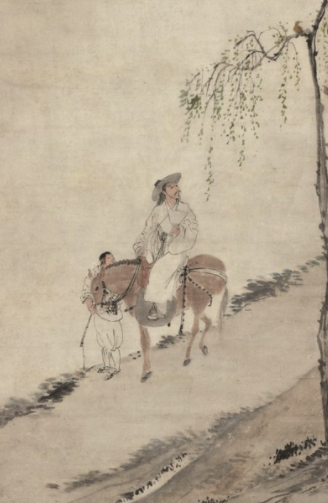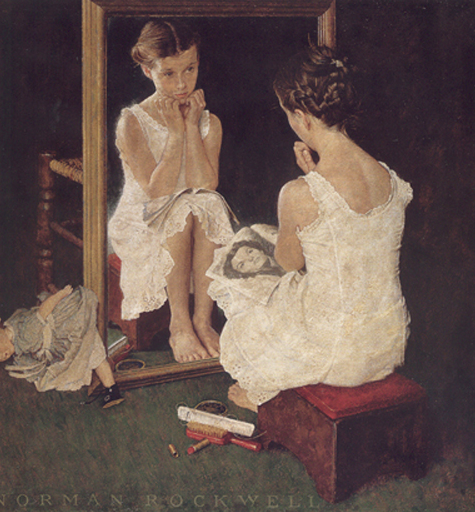Vanitas, 人生無常 In the East, the futility of possessions and attachments in life is expressed in this way. 人 生 無 常 If you apply the letters, human life is always nothing. In other words, the meaning of 人 生 無 常 means that human beings (人), born (life), never-before (non-existence), and always-same (常) are not always the same and are transitory. Likewise, in the West, this emptiness and meaningless of life is referred to as the Latin noun Vanitas [from the Latin adjective vanus meaning 'empty'] as 'emptiness', 'vain,' or 'valueless.' it was called to represent the pursuit of worldly things and temporary and worthless things. Although the sounds and words they call each other are different, they all mean the same thing. The oriental Vanitas paintings are mainly expressed and symbolized by dry branches, people walking alone and the moon. Unlike majestic landscape paintings or genre paintings that compose and fill the screen in a fun way, these paintings are characterized by a lot of blank space, in which texts or poems express the emptiness of life, and they are simple and deprived of a lot of energy. In contrast, in Western vanitas paintings, the skeleton symbolizing death is often the picture's main character. An hourglass representing ephemeral nature often appears as a supporting role next to it. It means that life is like the time remaining in an hourglass. It has limits and is not eternal. Mirrors often appear too, but there are cases where they express human vanity or draw regrets about youth's passing. Also, musical instruments appear frequently by comparing life's simplicity and ephemeral nature to musical instruments. There are many still-life paintings throughout, and it seems to fill the screen with various fruits, flowers, and tableware, but it is painted in dull and dark colors. (Image source by Wikipedia) Then, why did the painters paint such gloomy, dark and dull paintings as if they were competing? Were there many famines, wars, or adverse events at that time? So, did people draw these pictures to express their pessimism and emptiness? Ironically, however, in the case of Vanitas paintings, the still life paintings were famous in the Netherlands and Flanders in the 16th and 17th centuries, especially in medieval Europe. Mainly Christianity From the traditional Christian perspective, it often refers to the pursuit of worldly objects and temporary and worthless things. In the case of oriental paintings such as Vanitas styles, there are many memoirs and autobiographical paintings drawn by an individual as an adult as an older man looking back on his own life rather than instructive. Living in the glory and wealth, the elderly realized that life was only a fleeting moment and that it was like a midsummer night's dream. Everything disappears and becomes empty as time goes by. Suddenly, they apprehended the truth in the end of their life, they felt disappointed and depressed about nothing. But when they turned around, the water was flowing all around them, the mountains were still there, and birds were chirping beautifully from somewhere. In this way, they realized the meaning of life by looking at the nature that has always been with them at a constant temperature. They felt some unconditional and unwavering love from the great natural providence. Mountain is a mountain, and water is water. It is a famous sentence, made some inspirational trend by the famous monk Seongcheol in Korea. In other words, all things come from one origine, life is all about flowing into one stream without thinking and classifying about whether it is a mountain or water. Even the point out the exact definition to classify, is unnecessary to live in our life. How is more important which philosophy is right or which religion is the best ? Who can announce apparently which life is more perfect than those kind of life? He preached that life is to give up attachment to possessions and material things and to live naturally as if everything flows as one. In particular, when life is under the dark time, when we experience significant failures or betrayed from someone we trusted, we feel a' void of meaning' when vital things that were previously thought to make our life meaningful suddenly disappear. This is the sense of emptiness. There are times when this sense of emptiness creeps in. That's when you look back on the meaning of life and look back on your own life. I also drew a picture about an emptiness tag along the time. The title of the picture is "In the Moment". The beautiful flowers wither someday, and the splendid things of the world disappear without a sound when it's time to go down on the stage. That's why people want to capture and leave a beauty in their canvas to preserve the waving time. No one will eagle to see a dark, drab, gloomy picture hanging in their living room over and over again. However, with a hope, I would like to scan and fix the Moment the beauty was about to disappear. I took a canvas and drew a picture. Falling flowers scatter down with tears. Everything has a time, and both beauty and glory are temporary. But the record of that beautiful day will remain like this picture. The Moment remains in each person's mind like a photograph and a painting. When we want to teach someone a lesson, we find meaning in life and move forward. All Eastern painters and Western painters of Vanitas also realized the importance of life and moved forward. Since everything in the world is not eternal and even the glory is temporary, it is easy to become infinitely depressed and empty. Bernardo Strozzi, named il Cappuccino and il Prete Genovese (c. 1581 – 2 August 1644) was an Italian Baroque painter and engraver. One of his paintings shows an older woman looking in a mirror. The title of the painting is "The old Coquette". Two maids help an elderly noblewoman in front of make-up vanity. One of the maids is about to insert a beautiful feather between her gray hair. "You're probably still beautiful". The maid seems to be saying that. The noble lady looks in the mirror endlessly. She are grabbing the withered flower with her wrinkled hand. None of the props in the picture look lively and shiny. But her expression doesn't look sad and shabby. Instead, she shuts her mouth firmly, and her face feels karisma. Like the pretty girl in the 1954 Norman Rockwell painting Girl at the Mirror, she must have had a lovely and beautiful time. But even this cute girl in the Mirror will one day become the older man above. Although the most beautiful and youthful years of her life have passed shortly, probably she remembers her leeds days and seems to be realizing the meaning of her life. Because she is looking straight at herself in her mirror, when her flowers wither and droop and the working maid only looks at her decorations, she is the only one who sees herself in her face. In it, I saw her confidence. I think her dignified attitude like this is more remarkable than fancy decorations. Of course, the artist might have wanted to talk about the futility of the past, though. Confidence to face one's own eyes in the face of the passing years, this seems to be the same mindset that painters paint their portraits only after creating their own world for many years. When you suffer from insomnia due to the thought of a sense of emptiness that came one day, if you look straight into your eyes while appreciating the vanitas paintings left by previous artists, and looking straight into your eyes, it will help you to shake off the futility that came like an uninvited guest.
0 Comments
Leave a Reply. |
Myungja Anna KohArtist Categories
All
Archives
July 2024
|
Proudly powered by Weebly











 RSS Feed
RSS Feed